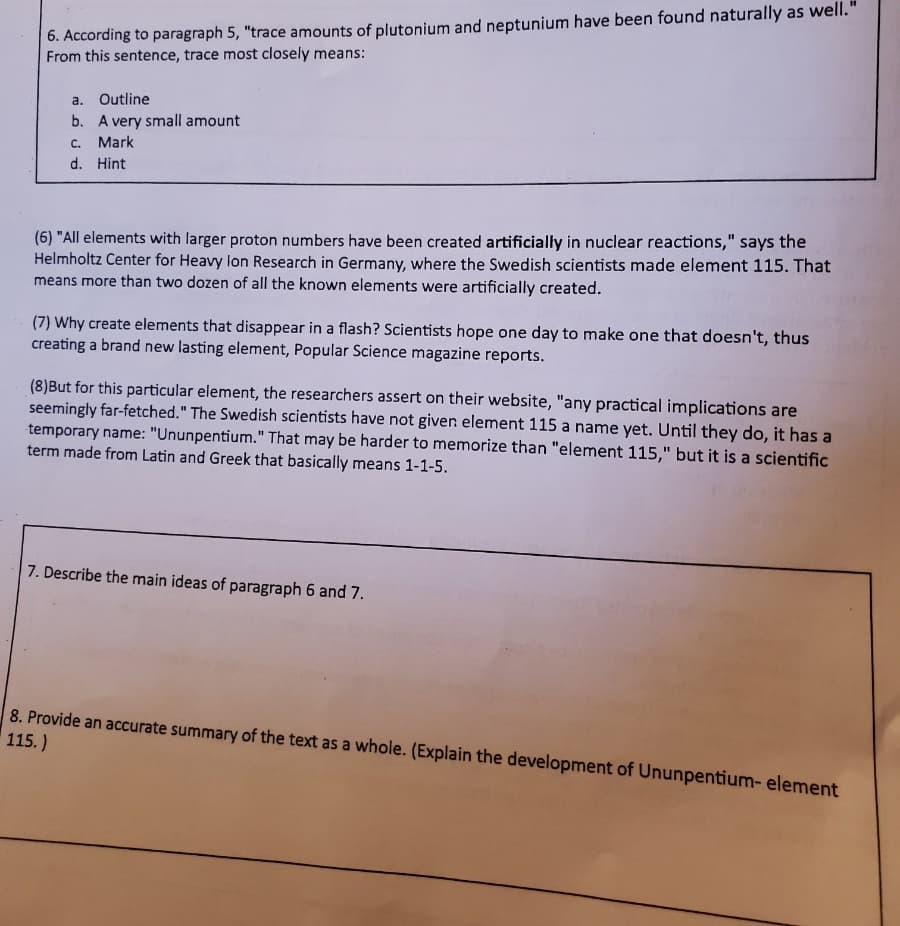6. According to paragraph 5, "trace amounts of plutonium and neptunium have been found naturally as well. From this sentence, trace most closely means: a. Outline b. A very small amount C. Mark d. Hint
6. According to paragraph 5, "trace amounts of plutonium and neptunium have been found naturally as well. From this sentence, trace most closely means: a. Outline b. A very small amount C. Mark d. Hint
Physical Chemistry
2nd Edition
ISBN:9781133958437
Author:Ball, David W. (david Warren), BAER, Tomas
Publisher:Ball, David W. (david Warren), BAER, Tomas
Chapter9: Pre-quantum Mechanics
Section: Chapter Questions
Problem 9.18E
Related questions
Question

Transcribed Image Text:6. According to paragraph 5, "trace amounts of plutonium and neptunium have been found naturally as well."
From this sentence, trace most closely means:
a. Outline
b. A very small amount
C. Mark
d. Hint
(6) "All elements with larger proton numbers have been created artificially in nuclear reactions," says the
Helmholtz Center for Heavy lon Research in Germany, where the Swedish scientists made element 115. That
means more than two dozen of all the known elements were artificially created.
(7) Why create elements that disappear in a flash? Scientists hope one day to make one that doesn't, thus
creating a brand new lasting element, Popular Science magazine reports.
(8)But for this particular element, the researchers assert on their website, "any practical implications are
seemingly far-fetched." The Swedish scientists have not given element 115 a name yet. Until they do, it has a
temporary name: "Ununpentium." That may be harder to memorize than "element 115," but it is a scientific
term made from Latin and Greek that basically means 1-1-5.
7. Describe the main ideas of paragraph 6 and 7.
8. Provide an accurate summary of the text as a whole. (Explain the development of Ununpentium- element
115.)
Expert Solution
This question has been solved!
Explore an expertly crafted, step-by-step solution for a thorough understanding of key concepts.
Step by step
Solved in 2 steps

Recommended textbooks for you

Physical Chemistry
Chemistry
ISBN:
9781133958437
Author:
Ball, David W. (david Warren), BAER, Tomas
Publisher:
Wadsworth Cengage Learning,

Chemistry & Chemical Reactivity
Chemistry
ISBN:
9781133949640
Author:
John C. Kotz, Paul M. Treichel, John Townsend, David Treichel
Publisher:
Cengage Learning

Chemistry & Chemical Reactivity
Chemistry
ISBN:
9781337399074
Author:
John C. Kotz, Paul M. Treichel, John Townsend, David Treichel
Publisher:
Cengage Learning

Physical Chemistry
Chemistry
ISBN:
9781133958437
Author:
Ball, David W. (david Warren), BAER, Tomas
Publisher:
Wadsworth Cengage Learning,

Chemistry & Chemical Reactivity
Chemistry
ISBN:
9781133949640
Author:
John C. Kotz, Paul M. Treichel, John Townsend, David Treichel
Publisher:
Cengage Learning

Chemistry & Chemical Reactivity
Chemistry
ISBN:
9781337399074
Author:
John C. Kotz, Paul M. Treichel, John Townsend, David Treichel
Publisher:
Cengage Learning

Chemistry: The Molecular Science
Chemistry
ISBN:
9781285199047
Author:
John W. Moore, Conrad L. Stanitski
Publisher:
Cengage Learning

Chemistry: Principles and Practice
Chemistry
ISBN:
9780534420123
Author:
Daniel L. Reger, Scott R. Goode, David W. Ball, Edward Mercer
Publisher:
Cengage Learning

Principles of Modern Chemistry
Chemistry
ISBN:
9781305079113
Author:
David W. Oxtoby, H. Pat Gillis, Laurie J. Butler
Publisher:
Cengage Learning